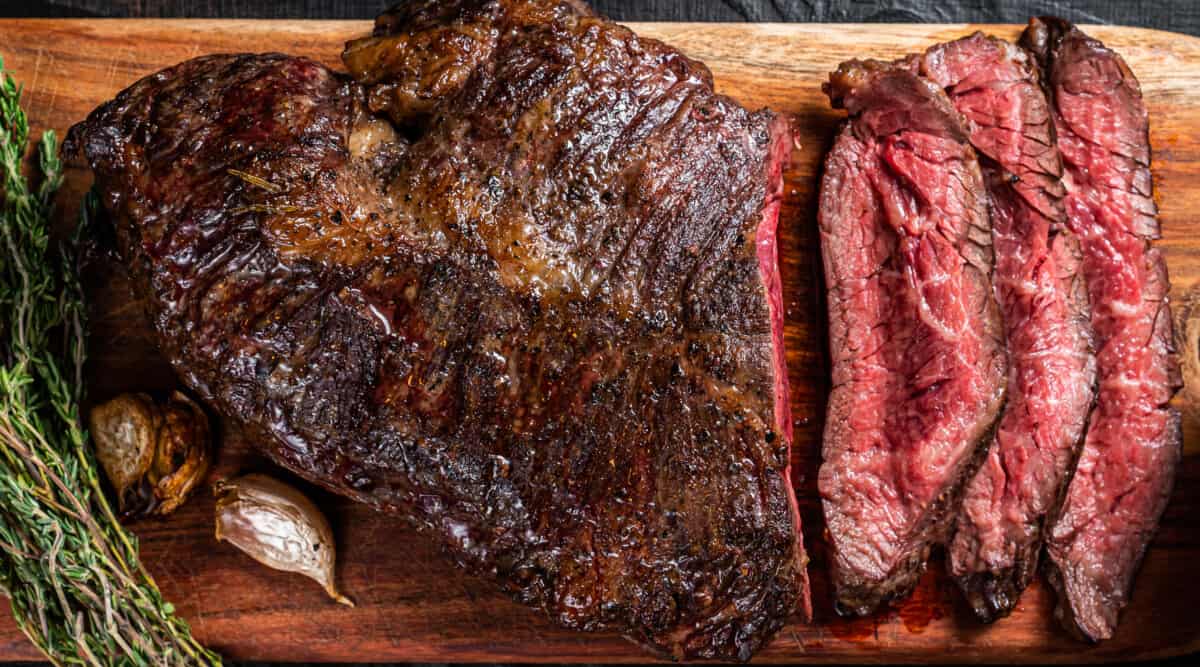
To perfectly season a steak, use 3/4 teaspoon of kosher salt per pound or 1/2 teaspoon of table of salt per pound, and apply it evenly to both sides well in advance of grilling, ideally overnight.
If you’re adding herbs and spices for flavor, add them right before putting your steak on the grill. Rosemary, thyme, and oregano are good choices, as are cumin, red pepper flakes, or cayenne pepper for some heat.
Save your black pepper for after the steak is cooked, as it can burn on the grill and taste bitter. The compound piperine, the best part of the pepper taste, will also burn away, and you will miss out on that flavor boost.
That is the short answer for how best to season your steak. However, there is a lot more to be discussed, including what kind of salts to use, how much to use, and the different times to add them. Plus, we need to discuss pepper and other spices and seasonings.
Then, it’s up to you to do what you will with the information. Enjoy experimenting with taste! Stick with our basic guidelines, though, and you really can’t go wrong.
Now, let’s begin with what you came here for. An in-depth discussion of the best way to season your steak.
Jump to:
My Recommendation for Seasoning Steak
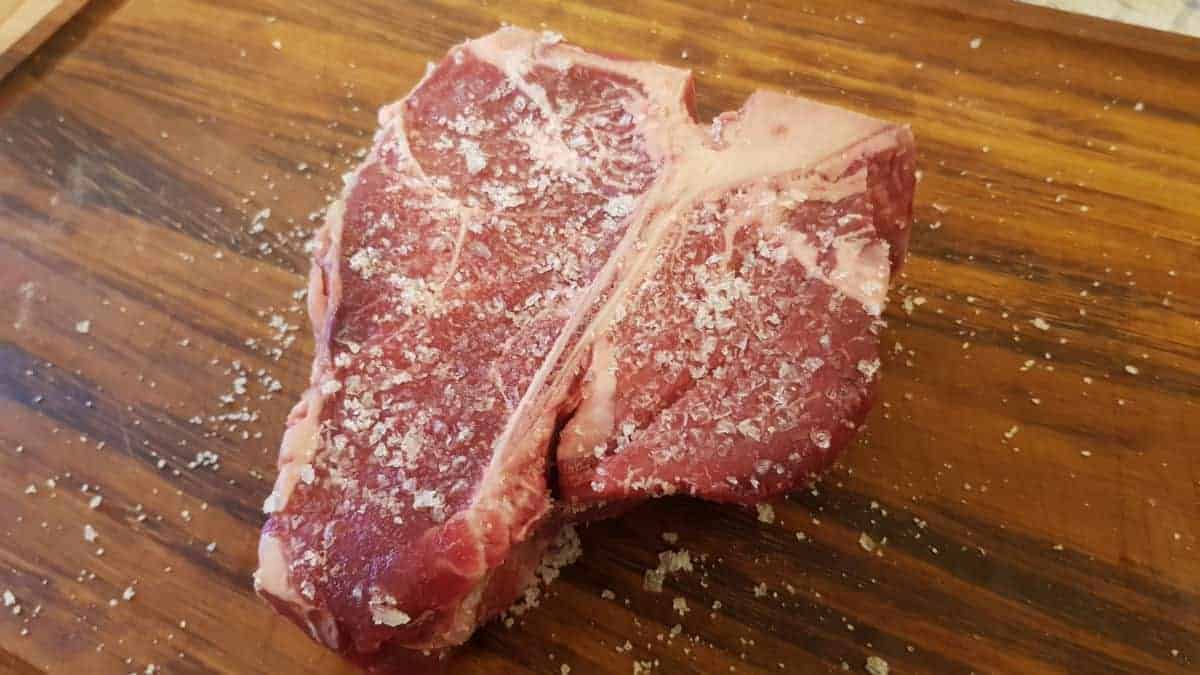
For the best results in seasoning steak, I apply a liberal coating of salt far in advance of grilling. In fact, overnight in the fridge is optimal. You’re effectively dry brining your steak for enhanced flavor and moisture retention. After that, it’s NADA until you’re done cooking!
If I cannot salt it overnight — Maybe I’m making an impromptu meal and bought a steak on the way home to cook right away — then the best times for seasoning with salt are in this order:
- Salt the night before, and allow the steak to sit on a wire rack uncovered.
- If not, salt AT LEAST 40 minutes before grilling. Earlier is better (1 hour, 2 hours, 5 hours, etc.)
- If salting at least 40 minutes in advance isn’t possible, then salt immediately before grilling.
Avoid salting during the 40 minutes before cooking. Salting draws out moisture, which needs at least 40 minutes to be reabsorbed, preventing the steak from drying out. Salting well in advance allows the salt to dissolve in the extracted moisture, reentering the steak through osmosis, seasoning it thoroughly, and keeping it moist.
I use kosher salt for seasoning steak. It’s a cleaner taste than table salt, and the larger crystals allow me to see how much I’ve added and where more easily. I use between 3/4 to 1 teaspoon of kosher salt per pound of steak.
If you have to use table salt instead, you should use less because it’s finer and more compact, giving more salt and a saltier taste per unit of volume. So use about 1/2 to 2/3 teaspoon of table salt per pound of steak.
Once the steak is grilled the way I like it, I allow it to rest before slicing against the grain and on a bias before serving. Now I top it with some freshly ground pepper.
You can sauce it up if you like for an extra layer of flavor. We’re partial to a chimichurri when we’re feeling saucy, and you can grab our tried-and-true chimichurri recipe here.
Not into sauce? Try a can’t-miss compound butter, like this wild garlic and bone marrow butter — pure sorcery!
Another option is to toss on herbs and spices before heading out to the grill. Hey, it’s your steak, so go for gold! There are no rules to enjoying food — we can offer guidelines and suggestions, but, in the end, only you can decide what tastes delicious.
Now you know how I do it, keep reading as we dive into the whys and hows of seasoning your steak so you can experiment armed with the right knowledge.
Is Seasoning Just Salting? Do Pepper, Herbs, and Spices Count Too?
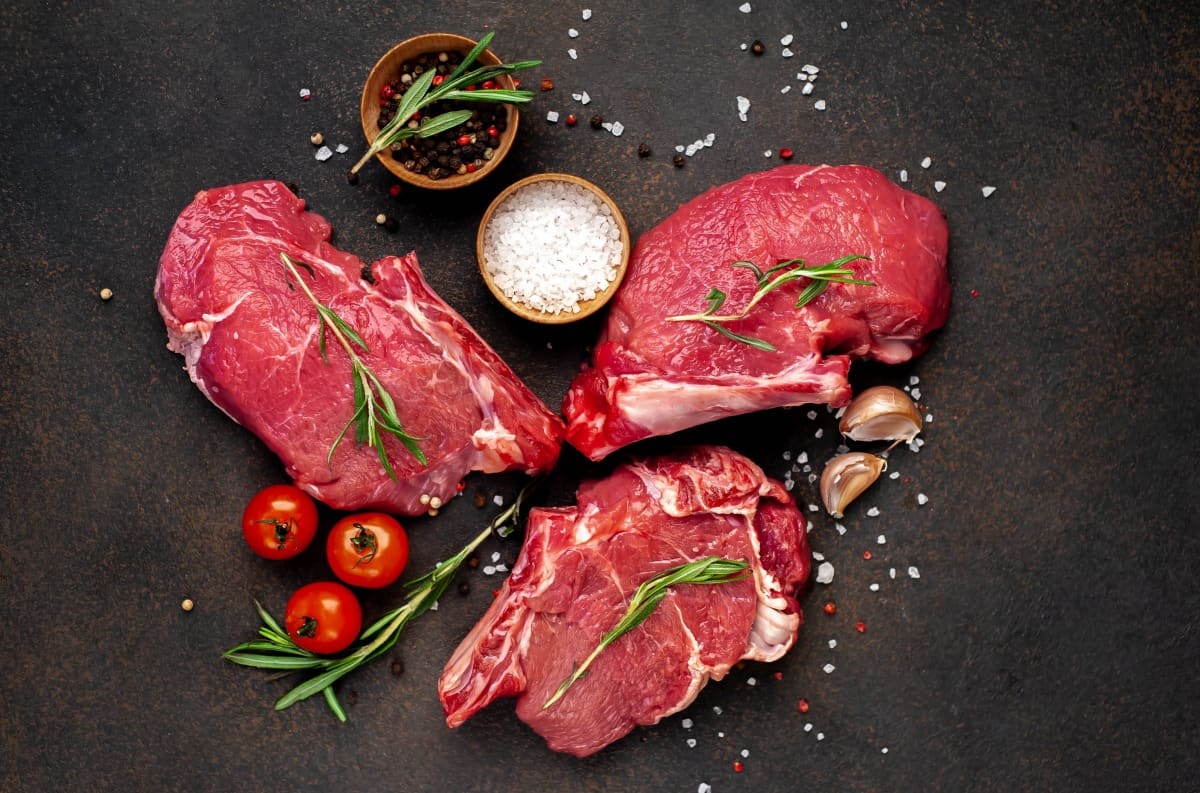
Salt is a seasoning, so even if you only salt your steak, technically, you’re seasoning it. And, yes, usually when we talk about “seasoning” a steak, we’re talking about salt.
Then there’s good old ground black pepper. If you’re at a “fancy” restaurant, they’ll bring around the grinder and sprinkle some on anything you want.
Of course, plenty of folks like to get in there with their favorites from the spice rack too. And maybe even some brown sugar. Me, I leave the brown sugar for ribs, but I suppose it could bring something interesting to a lower-grade steak.
And then, there are commercially prepared or homemade steak rubs, which are blends of several spices.
As far as rubs go, unless the blend is salt-based, there’s not much point in adding some ahead of time because it won’t do the same job. Instead, apply and rub it in shortly before grilling to build flavor in your crust.
At the end of the day, though, it’s your steak; you do you! Add whatever seasonings you enjoy, and don’t let anyone tell you different.
Best Type of Salt to Use
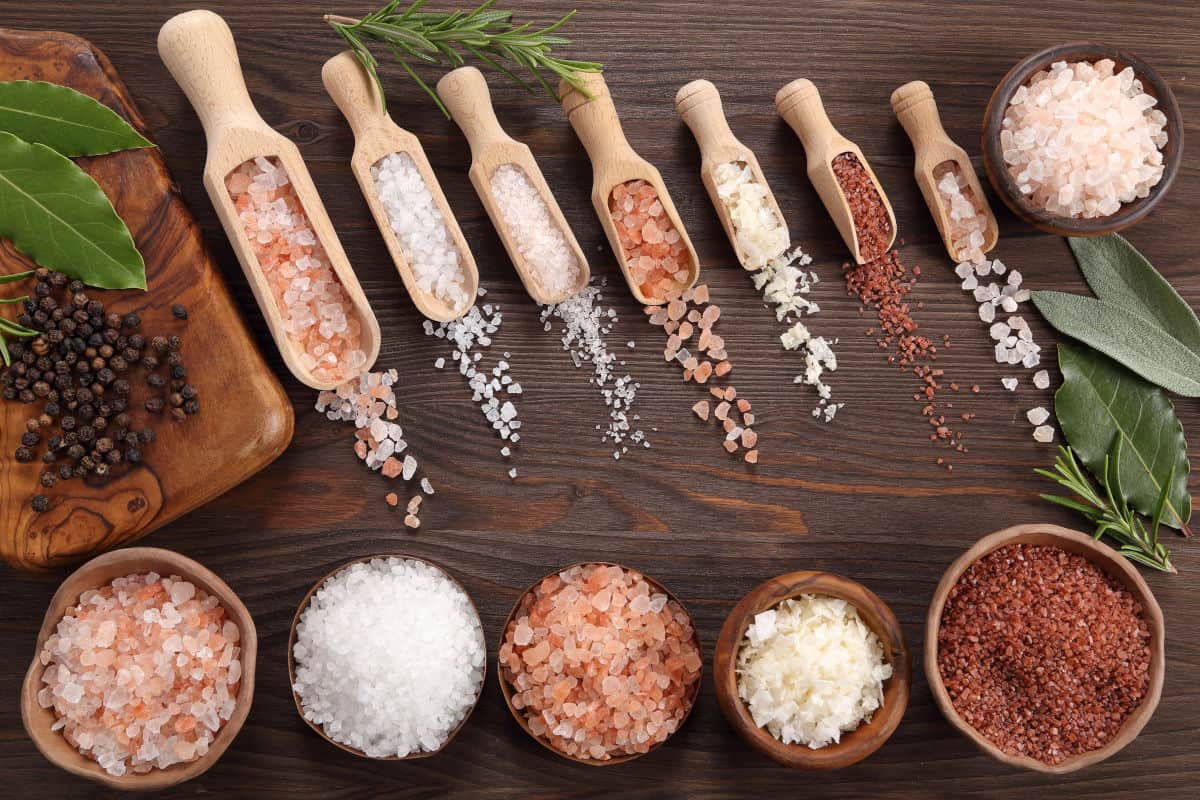
There are more types of salt than you can count on your fingers. But which is best for seasoning steak?
As a general rule, you want to use coarse-ground salt, that is, salt with large crystals. You can easily buy salt in this format, or you can grind your own in a salt mill.
Coarse salt is easy to work with; you can control the flow of salt, and it’s simple to pick up with your fingers. Also, it has a lot of surface area, so it imparts more flavor to your steak because of the size and all the points of contact.
Table salt, or iodized salt, is not a good choice for steak, even though you undoubtedly have lots of it in your kitchen already. It’s far too easy to pour way more table salt than you need because it’s so free-flowing. Also, it has a slightly bitter taste that may interfere with the taste of your steak when used in large quantities.
Probably the best-known and most readily available coarse salt is Kosher or Koshering salt. It’s inexpensive and works very well on steaks. Thanks to this combo of attributes, it’s our top choice for steak seasoning salt.
Sea salt is another good choice for large crystals, and so is Himalayan Pink salt. The only drawback for these salts is the price: both are typically far more expensive than Kosher salt. Also, there’s almost no detectable difference in taste, so it isn’t easy to justify their use on steak unless you’re seasoning in front of your guests and want to impress them.
To learn more about salt for grilling and cooking, click over to our comprehensive look at Different Types of Salt, How to Use each, and Substitutions.
How Much Salt to Use
The simple answer for how much salt to use is “a lot!” You want to apply your salt liberally to ramp up the flavor impact on your steak.
Ok, well, how much is that? Generally accepted wisdom among pitmasters, weekend warriors, and actual chefs is 3/4 to 1 teaspoon of kosher salt per pound of steak, or 1/2 to 2/3 teaspoon of table salt per pound.
I say that depends on the size of the steak. If you have a massive porterhouse with a lot of surface area, you’ll need a heavier hand to cover the whole thing than on a small sirloin. Also, a good bit of that salt will either miss the steak entirely as you sprinkle it on, some will fall off when you flip the steak, and some will be left behind on the grill.
If 1 teaspoon doesn’t sound like much salt, consider this: most health professionals feel that your maximum daily sodium intake should be about 2,300 mg — and 1 teaspoon of table salt contains just over that.
Of course, some folks will prefer a little less salt. And, you need to take into account any salt that might be in your spice rub, if you’re using any. It may take some delicious trial and error, but you’ll figure out what you prefer in time.
When to Season Your Steak
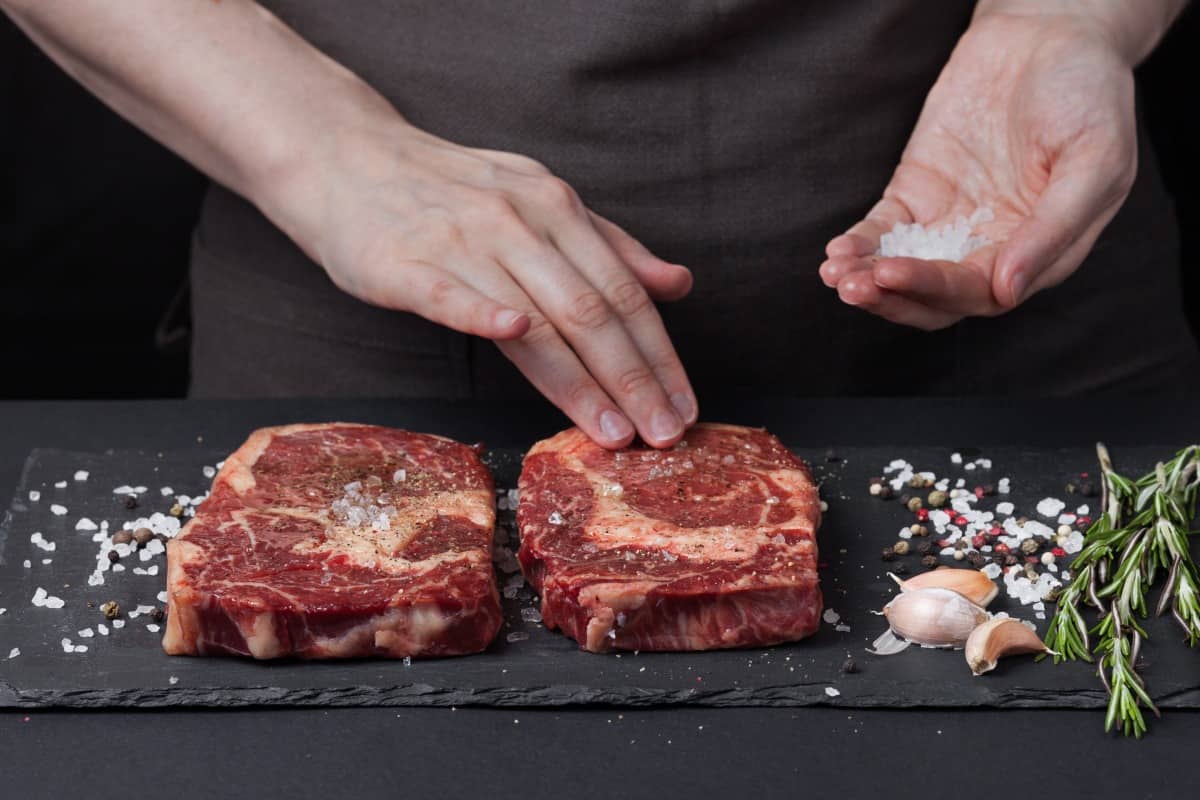
Now you know which salt to use and how much. When’s the best time to apply it? I’m happy you asked. Here are the pros and cons of each possible answer.
Well in Advance
Applying your salt at least 40 minutes before grilling is your first option. Even better is to let the salt sit on your steak overnight in the fridge. Doing so allows the salt to penetrate deep into the meat and work its magic.
Within a few minutes of application, salt starts to pull moisture out of the steak. After about 40–60 minutes (depending on how thick the steak is), the moisture is reabsorbed, leaving it juicy, extra-flavorful, and tenderized. Yes, you lose a small amount, but it’s honestly minuscule. Even sitting overnight, you won’t lose more than 5% or so.
What you’re doing is known as “dry brining,” and it’s a magnificent way to enhance almost any kind of meat. Want to know more? Then you’ll want to read this article: Dry Brining Guide — Turkey, Chicken, Steaks, Chops and More.
Right Before Cooking
Another way to do it, which might be the most common approach, is to salt just before hitting the grill. The thing is, most people are doing this wrong.
When I say “just before,” I mean JUST before! If you put salt on a steak, it starts to pull moisture out; you know this because we’ve already covered it. But, if you don’t leave it long enough, there’s no time for the moisture to reabsorb.
So, if you’re not going to salt your steak at least 40 minutes to an hour in advance, instead, you should do it no later than 3 minutes before you get to the grill.
The benefit to doing it this way is the salt is right there on the surface as you cook. This lets you build up a reasonable crust. Not as good as on a dry-brined steak, but not bad.
But, where there are pros, there are also cons. Not only won’t the crust be as robust, but you also won’t get the full impact on the flavor and tenderness. It’ll be yummy (salt is a natural flavor enhancer) but not melt-in-your-mouth, oh-my-god-I-am-the-grill-master yummy.
After Cooking
If you prefer just a small hit of salt (or forget to do it before cooking), you can add a pinch after grilling your steak. Of course, it won’t help your crust, and it won’t tenderize the meat, either. But, it will add some appealing surface flavor, just like any other seasoning might.
An added benefit of salting your steak after grilling is it’s easy to control the portion and “season to taste.”
The Great Pepper Debate — Does it Burn?
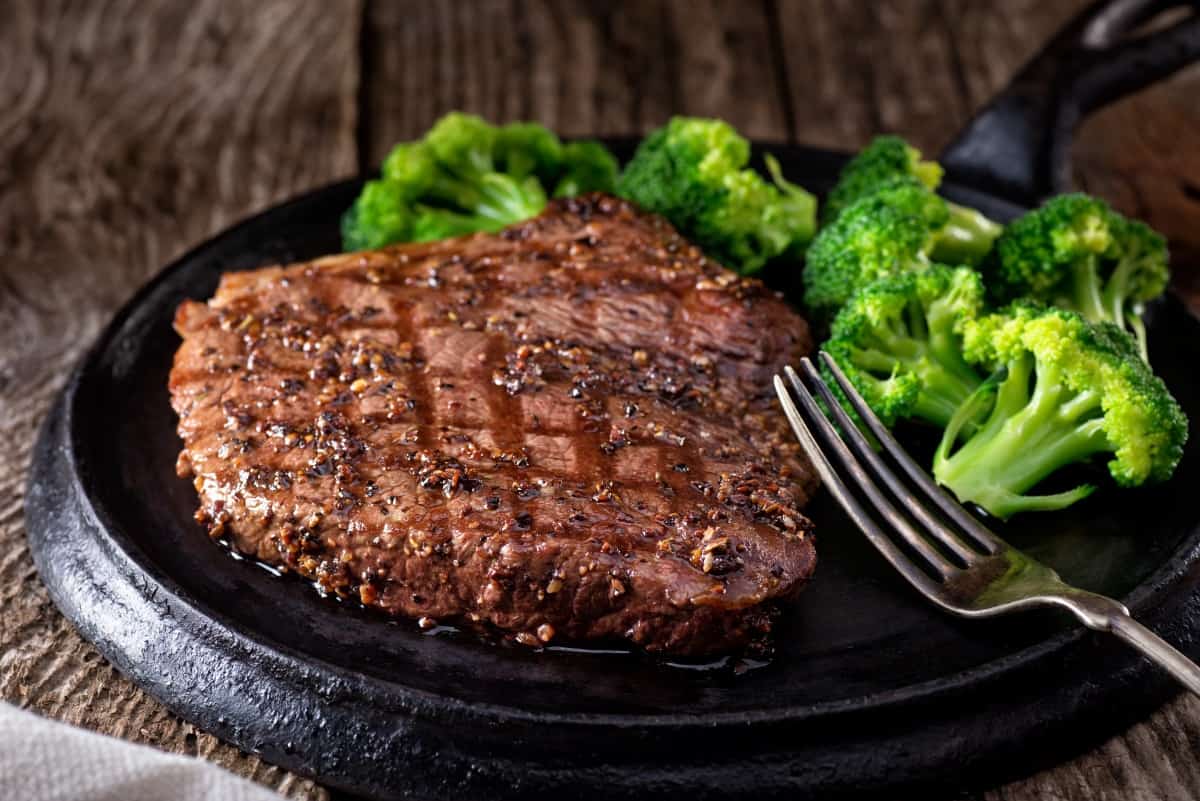
If I had a dollar for every “debate” in barbecue, well… let’s just say I’d buy better steaks more often. Today it’s pepper: does it burn if you add it to your steak before grilling?
The answer seems to be no, for the most part, but also sometimes yes. What’s up with that?
Finely ground pepper has a minimal surface area, so there’s not much to burn. Coarsely ground pepper has more surface area, so it’s more prone to burning, but only at extremely high temperatures.
For what it’s worth, burnt pepper does taste bitter and unpleasant. But, unless you’re using practically whole peppercorns and searing using the afterburner method, you’re unlikely to burn your pepper on the grill.
Peppering Before Grilling — Pros and Cons
Applying pepper to your steak before grilling means less time handling your steak when it’s finished and less time waiting to eat. Plus, you’ll somewhat get the pepper down into the flesh and experience the flavor beyond the surface.
On the other hand, you’re likely to lose a fair portion of pepper to the grate and flames.
Additionally, the compound that gives pepper much of its taste and bite, piperine, melts at 266 °F. Since we sear at upwards of 400 °F, you’ll melt away many of the benefits pepper brings to your steak. You’ll still taste pepper notes, but not the full effect you might be hoping for.
Peppering After Grilling — Pros and Cons
Pepper added after cooking will sit on the surface of the steak, mixing with any crust you’ve formed and juices resting on the top. You’ll get the whole pepper experience this way — all the taste and all the burn.
The only downsides I can imagine are the bit of time lost and the potential for too much pepper flavor, and that last one is only a problem if you don’t like pepper much in the first place.
For an excellent look at peppering your steak, check out this video from home cook extraordinaire Ethan Chlebowski.
Adding Herbs and Spices
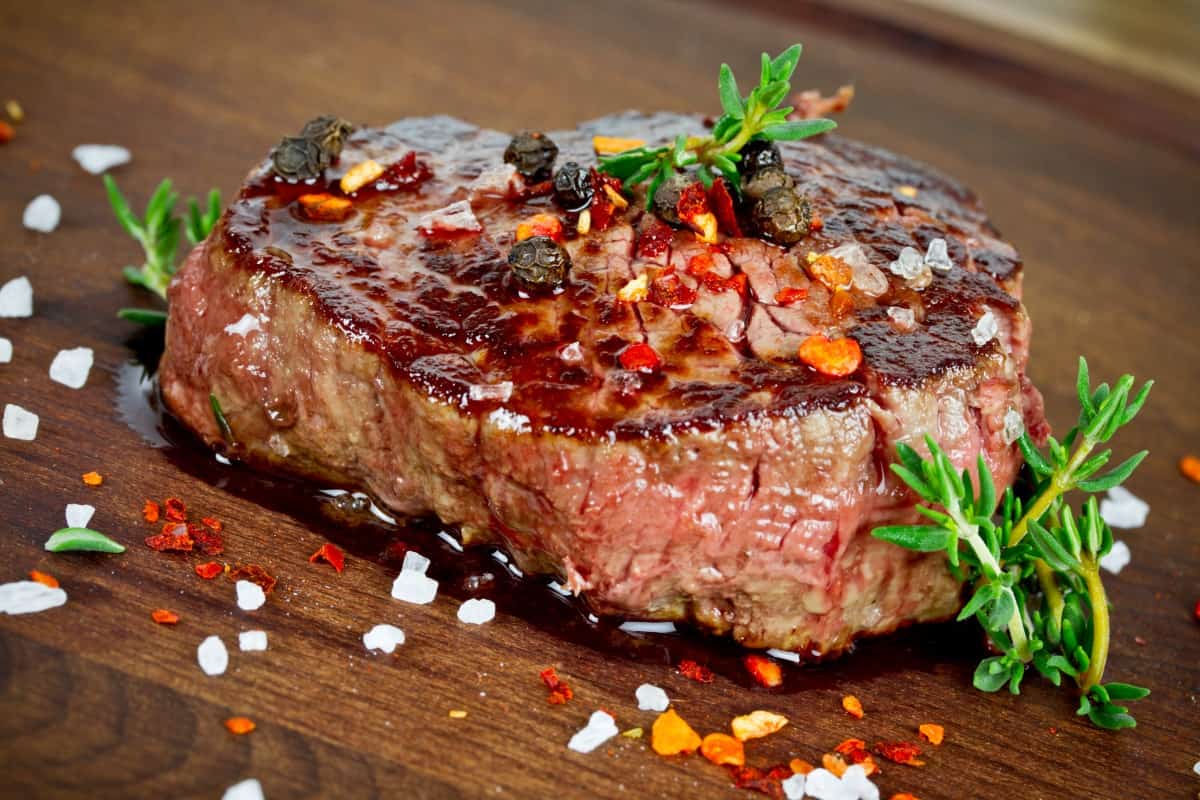
If you’ve looked at your spice rack anytime recently, you know there’s a lot more to “seasoning” than just S&P. What else goes well with steak?
Beef has a robust flavor all on its own. If you expect anything you add to it to make much of an impact, it needs to be up to the job. That means herbs and spices with plenty of, shall we say, oomph?
What Herbs and Spices Go Well?
You don’t have to get too exotic to add amazing flavor to your steak. Pantry staples like rosemary, thyme, and oregano are excellent choices for adding fragrance, a hint of woodiness, and even floral notes to steak. Fresh basil and parsley are also equal to the task.
Try cumin, red pepper flakes, or cayenne pepper for some heat with your meat.
When to Add Them?
The best time to add herbs and spices is right before putting your steak on the grill. There’s no real benefit to rubbing them in way ahead of time since they’re not there to cause a reaction like salt does.
Give a liberal sprinkling on the surface of your steak and press them in with the palm of your hand so they stick there.
Won’t They Burn During Cooking?
Anything will burn, given enough heat and time. But, most spices do not burn easily, and they typically have minimal surface area. (See our earlier bit on pepper for more on that.)
Plus, steaks aren’t in the heat for long, so there’s not much chance you’re going to singe your spices overly.
Final Thoughts
I hope your takeaway from this article on how to season steak is that flavor is what you make it. Yes, there are best practices for salting and seasoning steak. But it’s up to you to take those tips and make them your own.
And with that, another tasty treatise gets salted away. Hopefully, this article answered more questions for you than it raised, and you now have a game plan for your next steak cookout.
Thanks for reading! And please, leave your questions and comments for us in the form below. You’re in good company here.


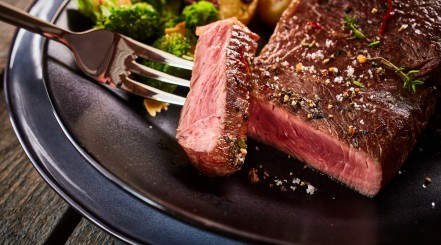

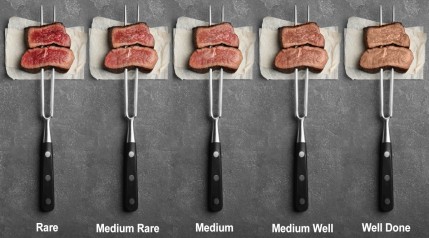
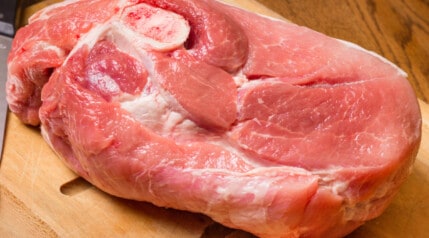
0 Comments